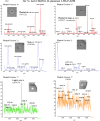A Multibacteriocin Cheese Starter System, Comprising Nisin and Lacticin 3147 in Lactococcus lactis, in Combination with Plantaricin from Lactobacillus plantarum
- PMID: 28476774
- PMCID: PMC5494623
- DOI: 10.1128/AEM.00799-17
A Multibacteriocin Cheese Starter System, Comprising Nisin and Lacticin 3147 in Lactococcus lactis, in Combination with Plantaricin from Lactobacillus plantarum
Abstract
Functional starter cultures demonstrating superior technological and food safety properties are advantageous to the food fermentation industry. We evaluated the efficacies of single- and double-bacteriocin-producing starters of Lactococcus lactis capable of producing the class I bacteriocins nisin A and/or lacticin 3147 in terms of starter performance. Single producers were generated by mobilizing the conjugative bacteriophage resistance plasmid pMRC01, carrying lacticin genetic determinants, or the conjugative transposon Tn5276, carrying nisin genetic determinants, to the commercial starter L. lactis CSK2775. The effect of bacteriocin coproduction was examined by superimposing pMRC01 into the newly constructed nisin transconjugant. Transconjugants were improved with regard to antimicrobial activity and bacteriophage insensitivity compared to the recipient strain, and the double producer was immune to both bacteriocins. Bacteriocin production in the starter was stable, although the recipient strain proved to be a more efficient acidifier than transconjugant derivatives. Overall, combinations of class I bacteriocins (the double producer or a combination of single producers) proved to be as effective as individual bacteriocins for controlling Listeria innocua growth in laboratory-scale cheeses. However, using the double producer in combination with the class II bacteriocin producer Lactobacillus plantarum or using the lacticin producer with the class II producer proved to be most effective for reducing bacterial load. As emergence of bacteriocin tolerance was reduced 10-fold in the presence of nisin and lacticin, we suggest that the double producer in conjunction with the class II producer could serve as a protective culture providing a food-grade, multihurdle approach to control pathogenic growth in a variety of industrial applications.IMPORTANCE We generated a suite of single- and double-bacteriocin-producing starter cultures capable of generating the class I bacteriocin lacticin 3147 or nisin or both bacteriocins simultaneously via conjugation. The transconjugants exhibited improved bacteriophage resistance and antimicrobial activity. The single producers proved to be as effective as the double-bacteriocin producer at reducing Listeria numbers in laboratory-scale cheese. However, combining the double producer or the lacticin-producing starter with a class II bacteriocin producer, Lactobacillus plantarum LMG P-26358, proved to be most effective at reducing Listeria numbers and was significantly better than a combination of the three bacteriocin-producing strains, as the double producer is not inhibited by either of the class I bacteriocins. Since the simultaneous use of lacticin and nisin should reduce the emergence of bacteriocin-tolerant derivatives, this study suggests that a protective starter system produced by bacteriocin stacking is a worthwhile multihurdle approach for food safety applications.
Keywords: bacteriocins; food safety; protective culture.
Copyright © 2017 American Society for Microbiology.
Figures








Similar articles
-
The effects of cultivating lactic starter cultures with bacteriocin-producing lactic acid bacteria.J Food Prot. 2001 Jan;64(1):81-6. doi: 10.4315/0362-028x-64.1.81. J Food Prot. 2001. PMID: 11198445
-
Technological characterization of bacteriocin producing Lactococcus lactis strains employed to control Listeria monocytogenes in cottage cheese.Int J Food Microbiol. 2012 Feb 1;153(1-2):58-65. doi: 10.1016/j.ijfoodmicro.2011.10.016. Epub 2011 Oct 30. Int J Food Microbiol. 2012. PMID: 22104121
-
Inhibitory activity of Lactobacillus plantarum LMG P-26358 against Listeria innocua when used as an adjunct starter in the manufacture of cheese.Microb Cell Fact. 2011 Aug 30;10 Suppl 1(Suppl 1):S7. doi: 10.1186/1475-2859-10-S1-S7. Epub 2011 Aug 30. Microb Cell Fact. 2011. PMID: 21995443 Free PMC article.
-
Developing applications for lactococcal bacteriocins.Antonie Van Leeuwenhoek. 1999 Jul-Nov;76(1-4):337-46. Antonie Van Leeuwenhoek. 1999. PMID: 10532388 Review.
-
Nisin variants: What makes them different and unique?Peptides. 2024 Jul;177:171220. doi: 10.1016/j.peptides.2024.171220. Epub 2024 Apr 16. Peptides. 2024. PMID: 38636811 Review.
Cited by
-
LAB Bacteriocins Controlling the Food Isolated (Drug-Resistant) Staphylococci.Front Microbiol. 2018 Jun 12;9:1143. doi: 10.3389/fmicb.2018.01143. eCollection 2018. Front Microbiol. 2018. PMID: 29946300 Free PMC article.
-
Functions and emerging applications of bacteriocins.Curr Opin Biotechnol. 2018 Feb;49:23-28. doi: 10.1016/j.copbio.2017.07.011. Epub 2017 Aug 5. Curr Opin Biotechnol. 2018. PMID: 28787641 Free PMC article. Review.
-
Potential Impact of Combined Inhibition by Bacteriocins and Chemical Substances of Foodborne Pathogenic and Spoilage Bacteria: A Review.Foods. 2023 Aug 20;12(16):3128. doi: 10.3390/foods12163128. Foods. 2023. PMID: 37628127 Free PMC article. Review.
-
Emerging Applications of Bacteriocins as Antimicrobials, Anticancer Drugs, and Modulators of The Gastrointestinal Microbiota.Pol J Microbiol. 2021 Jun;70(2):143-159. doi: 10.33073/pjm-2021-020. Epub 2021 Jun 21. Pol J Microbiol. 2021. PMID: 34349808 Free PMC article. Review.
-
Dietary Fibers and Protective Lactobacilli Drive Burrata Cheese Microbiome.Appl Environ Microbiol. 2017 Oct 17;83(21):e01494-17. doi: 10.1128/AEM.01494-17. Print 2017 Nov 1. Appl Environ Microbiol. 2017. PMID: 28842539 Free PMC article.
References
-
- Mills S, O'Sullivan O, Hill C, Fitzgerald GF, Ross RP. 2010. The changing face of dairy starter culture research: from genomics to economics. Int J Dairy Technol 63:149–170. doi:10.1111/j.1471-0307.2010.00563.x. - DOI
-
- O'Sullivan L, Morgan SM, Ross RP. 2007. Bacteriocins: changes in cheese flora and flavour, p 326–348. In Weimer BC. (ed), Improving the flavour of cheese. Woodhead Publishing, Cambridge, England.
-
- O'Connor PM, Ross RP, Hill C, Cotter PD. 2015. Antimicrobial antagonists against food pathogens: a bacteriocin perspective. Curr Opin Food Sci 2:51–57. doi:10.1016/j.cofs.2015.01.004. - DOI
Publication types
MeSH terms
Substances
LinkOut - more resources
Full Text Sources
Other Literature Sources
Research Materials

